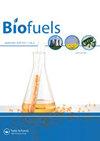Watermelon (Citrullus vulgaris) seed oil as a potential feedstock for biodiesel production in Nigeria
IF 2.6
4区 工程技术
Q3 ENERGY & FUELS
引用次数: 2
Abstract
Abstract Biodiesel fuel was successfully synthesized from Nigerian Watermelon (Citrullus vulgaris) seed oil through direct base-catalysed transesterification process using Methanol and sodium hydroxide as alcohol and catalyst, respectively. The solvent extraction method was used to extract the watermelon oil from the seed in order to determine its physic-chemical properties for relevant uses. Physical properties of the watermelon seed oil, its biodiesel and biodiesel blends were measured using the American Society for Testing and Materials (ASTM) methods for biodiesel and diesel fuels. Also, the effect of temperature and catalyst concentration on the biodiesel yield was studied. The properties of the produced watermelon oil and its biodiesel fuel were compared with that of vegetable oils from other feedstock and their respective biodiesel fuels. The result showed that the calorific value of the produced watermelon biodiesel is 40.10 MJ/Kg while that of the watermelon seed oil is 38.24 MJ/Kg. The cetane number, kinematic viscosity at 40 °C and pour point of the produced oil are 39.38, 8.50 mm2/s and 15 °C while that of the produced biodiesel are 53.165, 5.82mm2/s and 3 °C for Watermelon biodiesel, respectively. The maximum biodiesel yield (93.68%) was recorded at 55 °C with catalyst concentration of 1.0% of sodium hydroxide (NaOH) by weight. In comparison to biodiesel produced from other feedstock, the lower heating value and cetane number of watermelon seed oil methyl ester (40.10 MJ/kg and 53.165) were higher than that of palm kernel biodiesel (39.30 MJ/kg and 52.30), castor biodiesel (30.50 MJ/kg and 50), sandbox seed biodiesel (37.00 MJ/kg and 50), dika nut biodiesel (39.00 MJ/kg and 52) and kapok fibre biodiesel (40.064 MJ/kg), while that of physic nut biodiesel were higher. The obtained properties of watermelon seed oil and its biodiesel conformed to the ASTM standards for biodiesel and diesel fuels. The results further showed that watermelon seed oil is a potential feedstock for biodiesel production and the biodiesel produced can serve as an alternative fuel for diesel engines.西瓜(Citrullus vulgaris)籽油作为尼日利亚生物柴油生产的潜在原料
摘要以尼日利亚西瓜籽油为原料,分别以甲醇为醇、氢氧化钠为催化剂,采用直接碱催化酯交换法制备了生物柴油燃料。采用溶剂萃取法从西瓜籽中提取西瓜油,以确定西瓜油的理化性质。西瓜籽油及其生物柴油和生物柴油混合物的物理性质采用美国生物柴油和柴油燃料试验与材料协会(ASTM)的方法进行测量。研究了温度和催化剂浓度对生物柴油产率的影响。对所制得的西瓜油及其生物柴油燃料的性能与其他原料植物油及其生物柴油燃料的性能进行了比较。结果表明,制备的西瓜生物柴油的热值为40.10 MJ/Kg,而西瓜籽油的热值为38.24 MJ/Kg。西瓜生物柴油的十六烷值、40℃运动粘度和倾点分别为39.38、8.50 mm2/s和15℃,而西瓜生物柴油的十六烷值、40℃运动粘度和倾点分别为53.165、5.82mm2/s和3℃。在55℃、氢氧化钠(NaOH)质量分数为1.0%的条件下,生物柴油收率最高,为93.68%。与其他原料生产的生物柴油相比,西瓜籽油甲酯的热值和十六烷值(40.10 MJ/kg和53.165)高于棕榈仁生物柴油(39.30 MJ/kg和52.30)、蓖麻生物柴油(30.50 MJ/kg和50)、沙箱种子生物柴油(37.00 MJ/kg和50)、dika坚果生物柴油(39.00 MJ/kg和52)和木棉纤维生物柴油(40.064 MJ/kg),而物理坚果生物柴油的热值和十六烷值更高。所获得的西瓜籽油及其生物柴油的性能符合ASTM生物柴油和柴油燃料的标准。结果进一步表明,西瓜籽油是生产生物柴油的潜在原料,所生产的生物柴油可作为柴油机的替代燃料。
本文章由计算机程序翻译,如有差异,请以英文原文为准。
求助全文
约1分钟内获得全文
求助全文
来源期刊

Biofuels-Uk
Energy-Renewable Energy, Sustainability and the Environment
CiteScore
5.40
自引率
9.50%
发文量
56
期刊介绍:
Current energy systems need a vast transformation to meet the key demands of the 21st century: reduced environmental impact, economic viability and efficiency. An essential part of this energy revolution is bioenergy.
The movement towards widespread implementation of first generation biofuels is still in its infancy, requiring continued evaluation and improvement to be fully realised. Problems with current bioenergy strategies, for example competition over land use for food crops, do not yet have satisfactory solutions. The second generation of biofuels, based around cellulosic ethanol, are now in development and are opening up new possibilities for future energy generation. Recent advances in genetics have pioneered research into designer fuels and sources such as algae have been revealed as untapped bioenergy resources.
As global energy requirements change and grow, it is crucial that all aspects of the bioenergy production process are streamlined and improved, from the design of more efficient biorefineries to research into biohydrogen as an energy carrier. Current energy infrastructures need to be adapted and changed to fulfil the promises of biomass for power generation.
Biofuels provides a forum for all stakeholders in the bioenergy sector, featuring review articles, original research, commentaries, news, research and development spotlights, interviews with key opinion leaders and much more, with a view to establishing an international community of bioenergy communication.
As biofuel research continues at an unprecedented rate, the development of new feedstocks and improvements in bioenergy production processes provide the key to the transformation of biomass into a global energy resource. With the twin threats of climate change and depleted fossil fuel reserves looming, it is vitally important that research communities are mobilized to fully realize the potential of bioenergy.
 求助内容:
求助内容: 应助结果提醒方式:
应助结果提醒方式:


